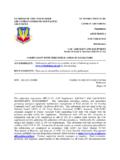Transcription of BY ORDER OF THE COMMANDER AIR FORCE …
1 BY ORDER OF THE COMMANDER air combat COMMAND AIR FORCE INSTRUCTION 91-203 air combat COMMAND Supplement 13 NOVEMBER 2017 Safety AIR FORCE CONSOLIDATED OCCUPATIONAL SAFETY INSTRUCTION COMPLIANCE WITH THIS PUBLICATION IS MANDATORY ACCESSIBILITY: Publications and forms are available on thee-Publishing website at for downloading or ordering. RELEASABILITY: There are no releasability restrictions on this publication. OPR: ACC/SEG Supersedes: AFI91-203_ACCSUP, 27 March 2014 Certified by: HQ ACC/SE (Col Robert Trsek) Pages: 6 AFI 91-203, AF Consolidated Occupational Safety Instruction, is supplemented as follows: It applies to commanders, functional managers, supervisors, and all other ACC personnel.
2 It does not apply to Air National Guard (ANG) or Air FORCE Reserve Command (AFRC) units and members. Forward recommended changes to this instruction on AF Form 847, Recommendation for Change of Publication, to HQ ACC/SEGO, 220 Sweeney Blvd, Langley AFB VA 23665- 2714. Note: The inclusion of any specific commercial product, commodity, or service in this publication is for information purposes only and does not imply endorsement by the Air FORCE . Ensure that all records created as a result of processes prescribed in this publication are maintained in accordance with Air FORCE Manual (AFMAN) 33-363, Management of Records, and disposed of in accordance with Air FORCE Records Information Management System (AFRIMS) Records Disposition Schedule (RDS).
3 Contact supporting records managers as required. This publication may be supplemented at any level, but all direct Supplements must be routed to the OPR of this publication for coordination prior to certification and approval. The authorities to waive wing/unit level requirements in this publication are identified with a Tier (T-2, T-3) number following the compliance statement. See AFI 33-360, Publications and Forms Management, for a description of the authorities associated with the Tier numbers. Submit requests for waivers through the chain of command to the appropriate Tier waiver approval authority, or alternately, to the Publication OPR for non-tiered compliance items.
4 2 AFI91-203_ACCSUP 13 NOVEMBER 2017 SUMMARY OF CHANGES Updated waiver authority to align with the AFI 36-360, Publications and Forms Management guidance. In the event of lightning and severe weather, adhere to procedures in AFMAN 91-201 for explosives handling, loading, and maintenance operations at all locations. (T-3) Contact the local Weapons Safety Manager for location purchasing and licensing requirements. Unit Safety Representative (USR) shall ensure compliance with all program elements during unit self-inspections. (T-2) Lockout/Tagout procedures will be reviewed during the annual inspection performed by a full-time ground safety professional and incorporated into the annual report.
5 For units that accomplish a stand-alone inspection of Lockout/Tagout, results of this inspection will be incorporated into each annual unit inspection report where applicable. (T-2) Sample Lockout/Tagout Procedures. The LOTO procedures shall be coordinated through the safety office. For ACC units without full-time safety personnel on non-ACC bases, coordinate with the host base safety office for assistance. (T-2) For additional information regarding lifting and handling requirements, consult MIL- STD-14720, DOD Design Criteria Standard Human Engineering, and AFI 91-203, Chapter 35, Materials Handling Equipment.
6 (T-2) When storing full or partially full aircraft oxygen converters on the flight line, the same distance criteria in TO 00-25-172 for LOX cart parking or storing will apply. (T-2) All electrical receptacles required for fuel servicing operations, ( , alert or special operations aircraft) that are located within a Fuel Servicing Safety Zone (FSSZ) as described in TO 00-25-172, will be UL-listed, explosion proof, and approved for use in Class 1 Division 1 and/or Class 1 Division 2 locations. (T-2) Additional guidance may be provided by Air FORCE Engineering Technical Letters.
7 Safety, Civil Engineering, and Fire Prevention personnel will be contacted for specific guidance. (T-2) Approval documentation for equipment not meeting requirements will be maintained within the immediate work area and at the Fire Department. Written requirements and procedures for use of temporarily approved equipment are required to be maintained with the equipment and will follow the general restrictions referred to in paragraph , Note: These provisions are to be used when an actual environment meeting Class I, Division 1 or Class I, Division 2, exists or could exist while the equipment is energized.
8 (T-2) (Added) Non-explosion proof and non-intrinsically safe computers, NDI equipment, and electrical test equipment may be used in Class I, Division 1 and Class I, Division 2 designated hangars on JP-8/Jet A aircraft as long as the following requirements are met: (Added) Non-explosion proof and non-intrinsically safe computers, NDI equipment, and electrical test equipment will not be used within the fuel servicing safety zone as described in TO 00-25-172. (T-2) AFI91-203_ACCSUP 13 NOVEMBER 2017 3 (Added) Before and while equipment is energized (see TO 1-1-3, para ), air samples will be taken with appropriate instruments to assure that no explosive/hazardous environment exists before equipment is used IAW TO 1-1-3.
9 (T-2) (Added) Use on JP-4 aircraft is not permitted. (T-2) Additional guidance for hot refueling operations is contained in AFI 21-101, Aircraft and Equipment Maintenance Management. (T-2) (Added) Containers utilized to dispose of contaminated waste will be properly marked to identify contents. Certain contaminated wastes may also be hazardous wastes, which require special handling and disposal under hazardous waste laws. All ACC bases have established procedures which must be followed for the storage and disposal of hazardous waste. Contact your Civil Engineering Installation Management Flight, Environmental Management Office, or unit hazardous waste monitor for additional guidance regarding disposal of hazardous waste/materials.
10 Safety and Bioenvironmental engineers may also be contacted for assistance. (T-2) (Added) Temporary Obstruction: These items must be highlighted with flashing lights, lanterns, or other appropriate devices approved by airfield management/operations and coordinated with the safety office and fire protection personnel. (T-2) Wing walkers will be used when towing an aircraft out of a hangar. (T-2) Personnel with chocks will walk within the vicinity of the main gear (not under the aircraft, unless directed by a TO) and be prepared to chock the wheels upon command of the supervisor.











